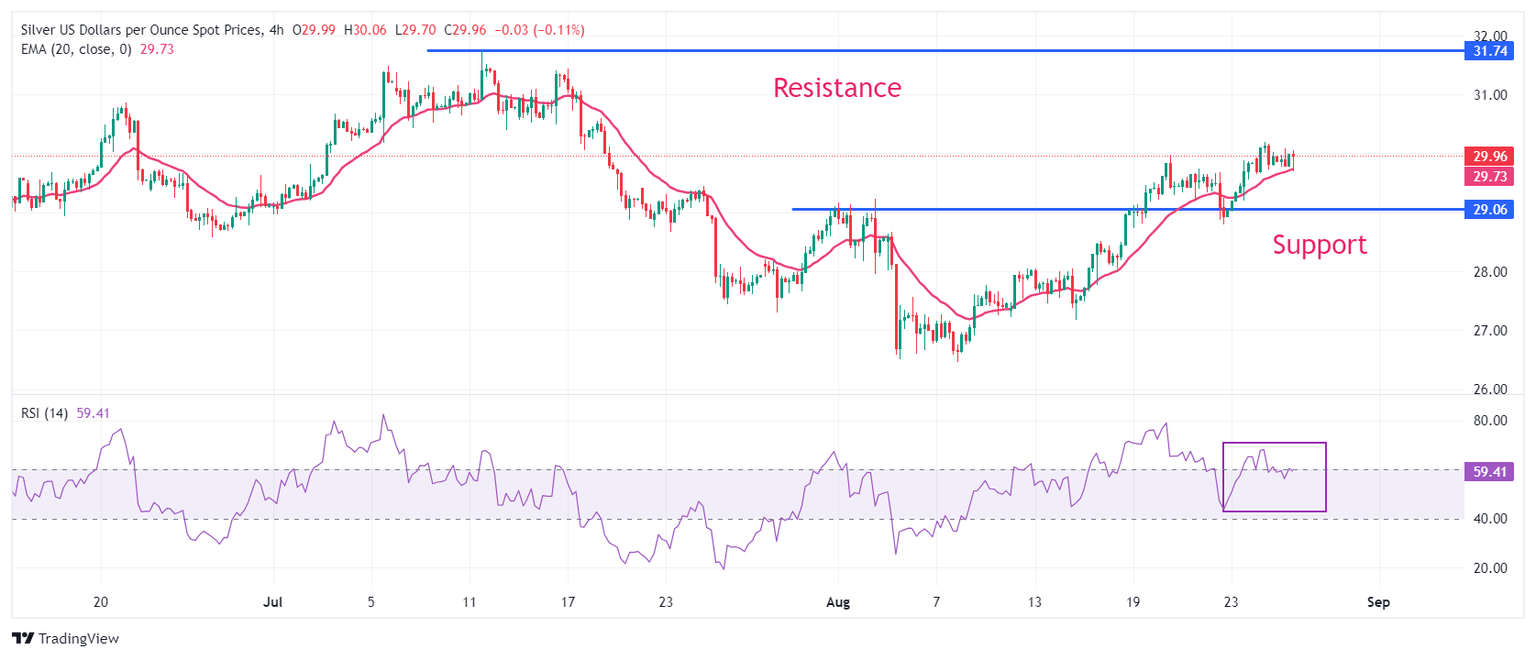Silver Price Forecast: XAG/USD struggles near $30 amid uncertainty over size of Fed interest rate cuts
- Silver price faces pressures in extending its upside above $30.00 as US bond yields surge.
- The Fed seems prepared to cut interest rates in September.
- Investors keenly await the US core PCE inflation data for July.

Silver price (XAG/USD) struggles to extend its upside above the psychological resistance of $30.00 in Tuesday’s New York session. The near-term outlook of the white metal remains upbeat as the Federal Reserve (Fed) is widely anticipated to start reducing interest rates from the September meeting. While investors seek clarity over the likely size by which the Fed will cut its key borrowing rates.
According to the CME FedWatch tool, 30-day Federal Funds Futures pricing data shows that the probability of a 50-basis points (bps) interest rate reduction in September is 28.5%, while rest are favoring a cut by 25 bps.
Meanwhile, San Francisco Fed Bank President Mary Daly supported a quarter-to-a-percentage interest rate cut in September in her interview with Bloomberg on Monday. However, she kept doors open for a bigger one if the labor market deteriorates.
Firm optimism for Fed interest rate cuts in September continues to weigh on the US Dollar and bond yields. The US Dollar Index (DXY), which tracks the Greenback’s value against six major currencies, sees more downside below the year-to-date (YTD) low of 100.53. 10-year US Treasury yields jump to near 3.86% amid caution ahead of the United States (US) core Personal Consumption Expenditure Price Index (PCE) data for July, which will be published on Friday.
Generally, higher yields on interest-bearing assets bode poorly for non-yielding assets, such as Silver, given that they reduce the opportunity cost of holding an investment in them.
Silver technical analysis
Silver price bounced back strongly after discovering firm buying interest near the August 1 high of $29.16 in a four-hour timeframe. The white metal is expected to extend its upside towards July 11 high of $31.75. Upward-sloping 20-day Exponential Moving Average (EMA) near $29.70 warrants more upside.
The 14-period Relative Strength Index (RSI) oscillates in the bullish range of 60.00-80.00, indicating a strong upside momentum.
Silver four-hour chart
Silver FAQs
Silver is a precious metal highly traded among investors. It has been historically used as a store of value and a medium of exchange. Although less popular than Gold, traders may turn to Silver to diversify their investment portfolio, for its intrinsic value or as a potential hedge during high-inflation periods. Investors can buy physical Silver, in coins or in bars, or trade it through vehicles such as Exchange Traded Funds, which track its price on international markets.
Silver prices can move due to a wide range of factors. Geopolitical instability or fears of a deep recession can make Silver price escalate due to its safe-haven status, although to a lesser extent than Gold's. As a yieldless asset, Silver tends to rise with lower interest rates. Its moves also depend on how the US Dollar (USD) behaves as the asset is priced in dollars (XAG/USD). A strong Dollar tends to keep the price of Silver at bay, whereas a weaker Dollar is likely to propel prices up. Other factors such as investment demand, mining supply – Silver is much more abundant than Gold – and recycling rates can also affect prices.
Silver is widely used in industry, particularly in sectors such as electronics or solar energy, as it has one of the highest electric conductivity of all metals – more than Copper and Gold. A surge in demand can increase prices, while a decline tends to lower them. Dynamics in the US, Chinese and Indian economies can also contribute to price swings: for the US and particularly China, their big industrial sectors use Silver in various processes; in India, consumers’ demand for the precious metal for jewellery also plays a key role in setting prices.
Silver prices tend to follow Gold's moves. When Gold prices rise, Silver typically follows suit, as their status as safe-haven assets is similar. The Gold/Silver ratio, which shows the number of ounces of Silver needed to equal the value of one ounce of Gold, may help to determine the relative valuation between both metals. Some investors may consider a high ratio as an indicator that Silver is undervalued, or Gold is overvalued. On the contrary, a low ratio might suggest that Gold is undervalued relative to Silver.
Author

Sagar Dua
FXStreet
Sagar Dua is associated with the financial markets from his college days. Along with pursuing post-graduation in Commerce in 2014, he started his markets training with chart analysis.


















